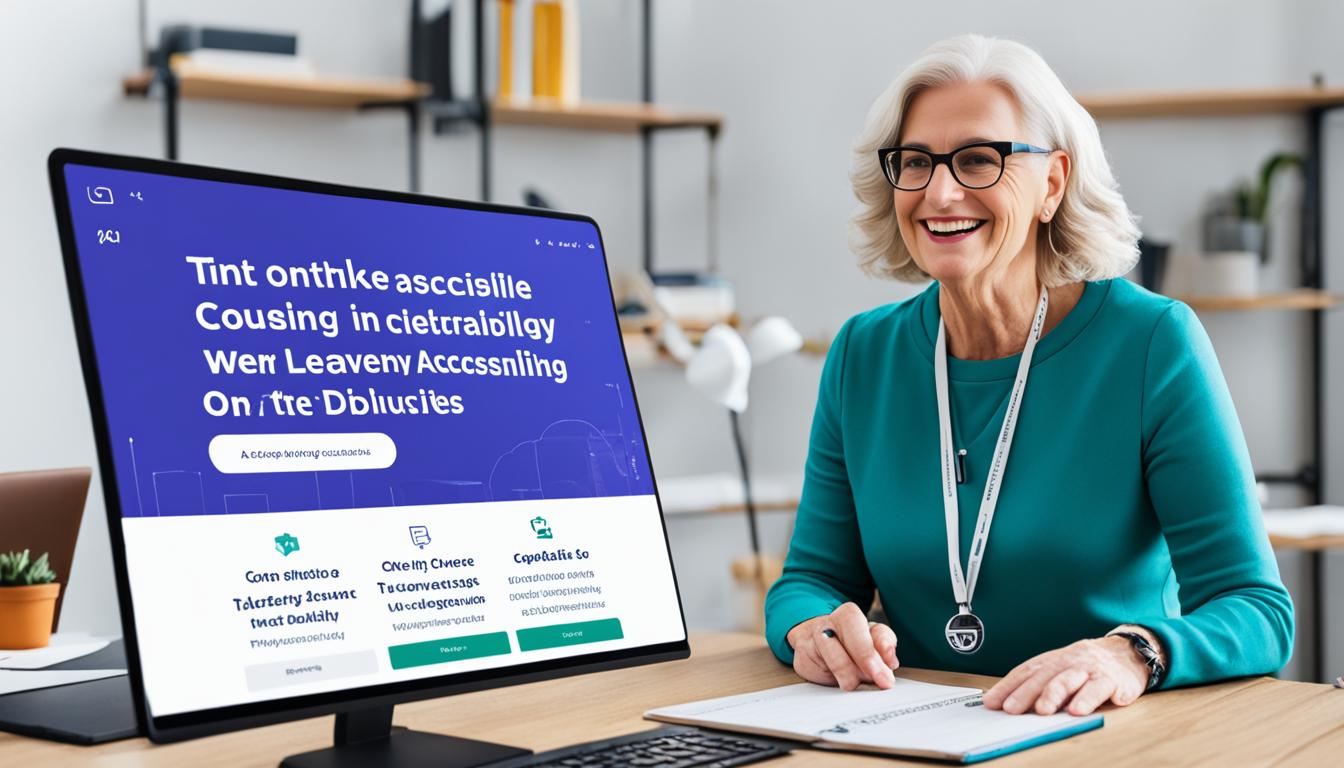A recent study shows that over 80% of online learning platforms now focus on making things easier for everyone. This big change marks a key moment in how we learn online. Schools and tech companies are working hard to make sure all students can use digital tools easily.
This article looks at the newest trends and ideas in making online learning accessible for 2024. We’ll cover new tools, research, and ways to make learning online better for everyone. You’ll learn how to make sure your online courses and platforms welcome all kinds of learners.
Key Takeaways
- Over 80% of online learning platforms are now prioritizing accessibility features
- Emerging assistive technologies are transforming the e-learning landscape
- Accessibility-focused research is driving innovative solutions for inclusive education
- Adopting universal design principles is crucial for creating accessible content
- User-centered design is a key strategy for meeting the needs of diverse learners
Emerging Assistive Technologies for Inclusive E-Learning
The world of online learning is always changing. So are the tools that make it accessible for everyone. Text-to-speech, speech recognition, and virtual and augmented reality are making e-learning more inclusive than ever.
Advancements in Text-to-Speech and Speech Recognition
New text-to-speech technology is making e-learning easier for students with disabilities. It offers voices that sound natural and lets students adjust how fast they hear the text. This helps students with visual or reading challenges.
Speech recognition also helps students. They can speak their thoughts and answers instead of typing. This is great for those who have trouble with physical or motor skills.
Innovative Virtual and Augmented Reality Solutions
Virtual reality (VR) and augmented reality (AR) are changing how we learn online. VR takes students into three-dimensional worlds. AR adds digital info to the real world, making learning fun and interactive.
These new technologies are helping all students learn in exciting ways. They let students explore, work together, and learn in a new way.
From text-to-speech to VR, new tools are changing e-learning. They make sure online classes are open to everyone, no matter their needs or abilities.
2024 Trends in Online Learning Accessibility: New Research and Innovations
The world is moving fast towards online learning, and making it accessible for everyone is now a top goal. New research and solutions are changing how we learn online. This makes sure that everyone can easily get into the course material.
One big change is that online learning must follow strict rules. Platforms must meet the Web Content Accessibility Guidelines (WCAG) 2.1. These rules help make digital content easy for everyone to use. So, we’re seeing more tools like better text-to-speech, easy navigation, and help for assistive tech.
Research in accessibility has made huge leaps forward. Scientists are looking into new tech like virtual and augmented reality. These could change how we learn online, making it more fun, interactive, and open to everyone.
Looking ahead to 2024, the future of online learning looks great. By following these trends and using new solutions, online learning can help every student succeed. No matter their abilities or how they like to learn.
- Stricter compliance with accessibility standards, such as WCAG 2.1, driving the development of more inclusive online learning platforms.
- Advancements in accessibility research, including the exploration of virtual and augmented reality technologies to create immersive and accessible learning experiences.
- A renewed focus on user-centered design principles to ensure that online learning is truly inclusive and accessible to all learners.
Accessible Content Creation and Universal Design Principles
Making e-learning accessible means focusing on creating content that everyone can use. By using universal design for learning, you make sure your online courses work for all learners, no matter their abilities.
User-Centered Design for All Learners
User-centered design is key to making content accessible. It means putting the learner first to make sure the content is easy to use and understand for everyone. This approach helps create online courses that fit different learning styles and abilities.
Using universal design, you can make sure your e-learning is easy to use. This includes adding text for images, making it easy to navigate with a keyboard, and using clear colors. By thinking about accessibility from the start, you make sure everyone can learn and succeed.
FAQ
What are the top trends in online learning accessibility for 2024?
For 2024, online learning accessibility is getting a boost with new tech. We’re seeing better text-to-speech and speech recognition. Plus, virtual and augmented reality are making learning more accessible for everyone.
There’s also a push for more research in making online learning accessible. And, we’re seeing the creation of platforms that follow the latest accessibility rules.
How are emerging assistive technologies transforming inclusive e-learning?
New tech like text-to-speech and speech recognition is helping students with disabilities. Virtual and augmented reality are also making learning more immersive and open to all.
What are the key trends in accessibility research and innovative solutions for online learning?
Research and innovation are leading to more inclusive online learning platforms. These platforms meet the newest accessibility standards. This means we’re moving towards more accessible e-learning experiences in 2024 and the future.
How can I ensure my online courses and materials are accessible to all learners?
To make your online content accessible, use design that focuses on the user. Follow universal design for learning principles. This way, you can make sure all learners have an equal and engaging experience.
